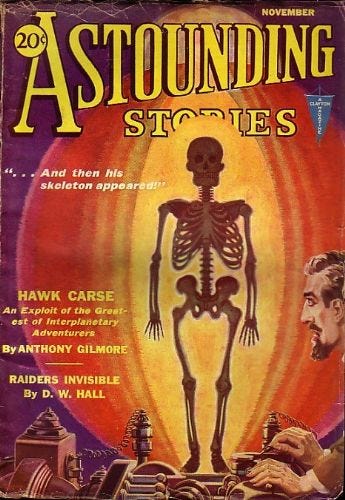The back of Galaxy magazine in the 1950s had “You won't read it here.” What followed featured Bat Durston. Western prose with a few futuristic flourishes as science fiction window dressing. I have to admit to not really coming across a “space western” within the science fiction pulp magazines in my earlier years.
There was one blatant (and popular) space western series in the pulps: Hawk Carse by Harry Bates and Desmond Hall. Bates was an editor for the Clayton chain of pulps. Desmond Hall his assistant. Mr. Clayton had decided to get into the science fiction pulp market as you had Amazing Stories, Air Wonder Stories, Science Wonder Stories at the time. Clayton was a pulp publisher with emphasis on adventure, not a publisher of bed-sheet sized fiction magazines that were an out growth of popular science publishing.
Astounding Stories had its first issue January 1930. This was not to be scientific gadget stories but adventure with some scientific window dressing. Harry Bates wrote an introduction to A Requiem for Astounding on the difficulty filling the magazine. Clayton used a lot of Murray Leinster, Victor Rousseau and Ray Cummings who had been writers of scientific romance for the Munsey magazines. Some writers from the Gernsback magazines were used: Capt. S. P. Meek, R. F. Starzl, Harl Vincent. Bates also brought in some adventure writers: Hugh B. Cave, F. van Wyck Mason, and Tom Curry. Bates used some newer and younger writers including Jack Williamson.
Bates and Hall had a number of stories under pseudonyms in the pages of Astounding. One of those pseudonyms was “Anthony Gilmore.” It was under the Anthony Gilmore name that the four “Hawk Carse” stories appeared as.
There were four Hawk Carse stories:
Hawk Carse November 1931
The Affair of the Brains March 1932
The Bluff of the Hawk May 1932
The Passing of Ku Sui November 1932
“Hawk Carse” opens with the titular character on his way to his ranch on the Saturn moon of Iapetus. He harvests horns from a native animal that herds. The opalescent horns fetch a very good price back on Earth. He receives word the ranch is under attack from minions of the master criminal Ku Sui. He finds his ranch hands dead and so begins the adventure over four novellas with Carse and his companions Friday and “master scientist” Eliot Leithgow battle super criminal “Eurasian” Ku Sui. You have space opera with elements of the western and Fu Manchu.
There are jungles on the moons of Jupiter, asteroid hide-outs, enslaved brains, and some ray-gun fu. For some reason never explained, Hawk Carse wears his blond hair in bangs almost to his eye brows and never lets anyone see his forehead. Five of Ku Sui's minions had humiliated Carse in the past.
Harry Bates solo later wrote “The Return of Hawk Carse” for Amazing Stories, July 1942. The four stories from Astounding were rewritten and turned into a fix up novel Space Hawk (Greenberg, 1952).
I have read better space opera. I have never lost my enthusiasm for Jack Willliamson's A. Merritt influenced early and mid 1930s fantastic adventures. Same for P. Schuyler Miller, Manly Wade Wellman, Raymond Z. Gallun. Their stories are much better.
I have been told that the western pulp magazine audience turned over every three years. The early teen readers moved on after three years. The Hawk Carse stories appear aimed at a younger audience. The series was popular with the readers of Astounding Stories. Looking at the fictionmags index for both Bates and Hall show neither ever wrote a western story.
Harry Bates would go on to write some more than competent science fiction stories for the Street & Smith era Astounding Stories. He wrote the somewhat famous “Farewell to the Master” that was adapted as the movie The Day the Earth Stood Still.
You can find the Hawk Carse stories online with minimal searching if you are so inclined. I have the 1952 hardback that I found back in the 90s at an antique/junk shop.
The stories lack the sincerity of E. E. “Doc” Smith, Edmond Hamilton, John W. Campbell, and Jack Williamson. All of whom I highly encourage to check out as part of your classic science fiction education.








Oooh, thanks for the names! I went hunting for Jack Williamson and found his very good short story Salvage in Space on Amazon. On Open library I found his other books and had a great time reading the League of Space, which is literally "the Three Musketeers fight aliens to save a girl". It also occurred to me that these stories were videogames before videogames, because that hero dies multiple times and respawns. (He just falls unconscious to escape every bad situation, lol!) I want to look up those other authors, too.